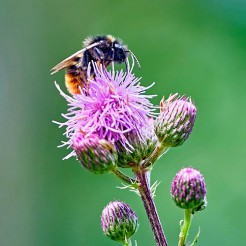The Cotton Thistle is native to Central Europe, from Ukraine to Greece and from Turkey to Pakistan. The plant also grows wild in Great Britain, the Netherlands and Belgium, but is very rare in the latter two countries. It is a hardy, biennial plant that grows into a very broad and tall plant. The entire plant, including the leaves and stems, is covered in white, felt-like hairs. The stems and leaves are very sharply spiked. The flowers are purple/red and stand above a spherical involucre. In the first year, the plant mainly develops underground. It forms a taproot with a rosette. In the second year, the plant grows upwards. The plant dies after flowering. It is a plant that is very similar to other thistles. It grows on dry, calcareous, nitrogen-rich and open soil, often found in the dunes, near rivers and in South Limburg. The plant is edible. Both the stems and the flower buds can be cooked, and the petals can be used as a cheap alternative to saffron. It flowers from July till September in the second year after sowing. This plant is very attractive to bees, butterflies and other beneficial insects. Hardy biennial.









